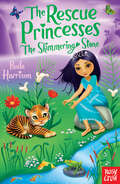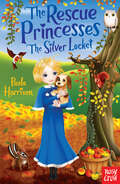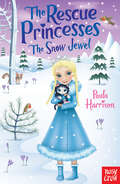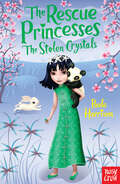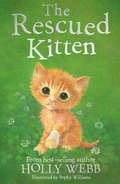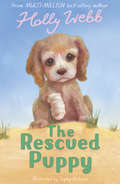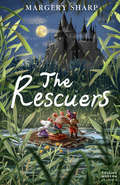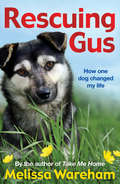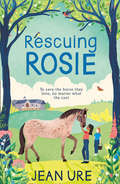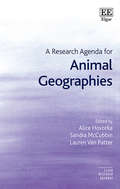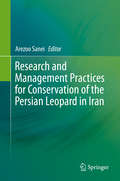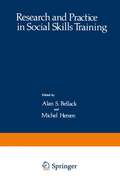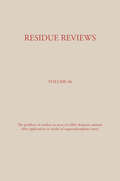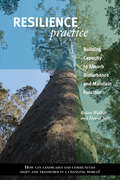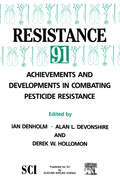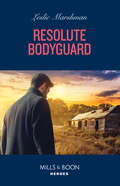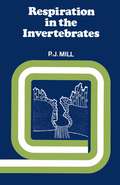- Table View
- List View
The Rescue Princesses: The Shimmering Stone (The Rescue Princesses)
by Paula HarrisonPrincess Amina is so pleased her friends are coming to her cousin's wedding. The Princesses can't wait to put on their best dancing shoes! But when a wounded tiger is found in the hills, the girls know her small cubs will be in terrible danger. The Rescue Princesses must find them, royal wedding or no royal wedding…
The Rescue Princesses: The Silver Locket (The Rescue Princesses)
by Paula HarrisonRosalind and the other princesses are in the Kingdom of Taldonia for the Autumn Ball. They love playing with a little puppy called Patch. But they can't stop arguing, and Rosalind decides it's easier to be friends with animals than with silly princesses. She goes off on her own, and that's when disaster strikes! Patch gets lost in the woods and Rosalind needs the other Rescue Princesses to help find him. But what if they're not her friends any more?
The Rescue Princesses: The Snow Jewel
by Paula HarrisonThe Rescue Princesses are sledging through the beautiful snow of Northenland when they meet Princess Freya. She would love to join them but her father, King Eric, thinks sledging is too dangerous for a proper princess. Freya longs to prove him wrong, and impress her new friends too!
The Rescue Princesses: The Stolen Crystals
by Paula HarrisonThe Rescue Princesses are having such fun staying with Jaminta! The Kingdom of Onica is amazing, with its Cloud Mountain and the tiny baby panda who lives there… The mountain is also home to the lost Onica Crystals. But someone is out to steal them - someone who won't let a baby panda stand in their way. Can the Rescue Princesses find the crystals first and keep the baby panda safe from the thieves?
The Rescued Kitten (Holly Webb Animal Stories #39)
by Holly WebbEdie and her friend Layla are on their way home from school when they discover a tiny ginger kitten caught up in some barbed wire. She looks weak and has a cut on her leg from the wire, so they rush her home to Edie’s mum, a vet. Edie’s mum isn’t sure that the little kitten is going to make it, as she’s too small to have been separated from her mother and needs bottle-feeding round the clock. But Edie is determined to nurse Barbie back to health and find out what has happened to the rest of the kittens in the litter and their mum. What if they’re in danger, too?
The Rescued Puppy (Holly Webb Animal Stories #18)
by Holly WebbTwins Georgia and Adam can’t wait to go on their holiday to Cornwall – especially as it’s the first time they’re taking their new puppy, Lucky, with them. Lucky loves the seaside – chasing the waves, digging in the sand and the long cliff-top walks. One day, the children go out by themselves, but they get into difficulty and the puppy ends up falling partway down a cliff. Unable to reach him themselves, the twins are distraught to see Lucky’s paw is hurt, too. Will they find a way to rescue poor Lucky?
The Rescuers (Collins Modern Classics)
by Margery SharpBianca and Bernard, agents for The Prisoners' Aid Society of Mice, rescue prisoners and outwit villains in this enchanting story, made world-famous by the Walt Disney film.
Rescuing Gus
by Melissa WarehamMelissa Wareham loved her job at Battersea Dogs & Cats Home, caring for lost and abandoned animals. When Gus - elderly, smelly and poorly - arrives at the Home one day, she knows that she has found the dog for her - and that he has found the human for him!Life with Gus takes some getting used to... from him insisting on drinking out of the toilet bowl, his sleep-destroying snores and his bath-aversion tactics... but Gus is a funny, gentle, loving dog and Melissa and he quickly become completely inseperable.This is a funny, sad, wise and kind tale of the joy that adopting a rescue animal brings.
Rescuing Rosie
by Jean UreA brand-new adventure about animals and friendship. From the legendary author of the bestselling Frankie Foster series, Jean Ure.
Research Advances in Alcohol and Drug Problems (Research Advances in Alcohol and Drug Problems #8)
by Reginald G. Smart, Howard D. Cappell, Frederick B. Glaser, Yedy Israel, Harold Kalant, Robert E. Popham, Wolfgang Schmidt and Edward M. SellersThis volume is the eighth in the Research Advances Series and the fifth published by Plenum Press. The purpose of the series is to review new work in rapidly changing fields. We do not expect reviews to cover the whole field of work on alcoholism and addiction. Nor do we expect that they will be like annual reviews covering all work in a delimited field. Our reviews are designed to explore only the most exciting parts of the total field and to focus on conclusions that can be made about them. The series publishes one volume each year. Volume 8 is an omnibus rather than a theme volume in that a wide range of topics is covered, including research on alcohol, opiates, and tobacco. As usual, the greater emphasis is on alcohol research, reflecting the importance of the problem and the volume of work to be reviewed. With Volume 8 come some changes in the Editorial Board. It will be the last volume in the series for Robert E. Popham who has resigned from the Board. He has been with the series since its inception and has contributed a great deal to its development. The members of the Board are grateful for his help. We are adding two new members: Dr. Howard Cappell, whose field is experimental psychology, and Dr. Edward M. Sellers, in clinical medicine and pharmacology.
A Research Agenda for Animal Geographies (Elgar Research Agendas)
Elgar Research Agendas outline the future of research in a given area. Leading scholars are given the space to explore their subject in provocative ways, and map out the potential directions of travel. They are relevant but also visionary.Exploring the innovative and thriving field of animal geographies, this Research Agenda analyses how humans think about, place, and engage with animals. Chapters explore how animals shape human identities and social dynamics, as well as how broader processes influence the circumstances and experiences of animals.This Research Agenda presents recent forays into theories of power, methodological innovations unearthing animal lifeworlds, and commitments to praxis. It demonstrates opportunities for animal geographies to engage creatively with diverse movements, including industrial farm workers' rights, intersectional feminism, the environmental movement, racial equality, and decolonization. Critical and timely, contributions from top and emerging scholars suggest that it is time to bring the animals outwards into broader geographical dialogue to address pressing contemporary issues such as climate change.An important read for animal and human geographers, this will be a foundational text for emerging scholars interested in critical perspectives on human-environment relations and societal dynamics. Its grounding in historical evaluation, discussion of scholarly innovation in the field and the opportunities to reflect on the topic in a time of socio-ecological crisis will also be helpful for more established scholars.
Research and Management Practices for Conservation of the Persian Leopard in Iran
by Arezoo SaneiThe population of the Persian leopard (Panthera pardus saxicolor) has drastically declined; this Asian leopard subspecies has disappeared from some parts of its former range. Containing large areas of potential habitats with leopard presence across almost all of its provinces, Iran is known to be the last stronghold for the Persian leopard in the region. This book comprehensively covers research, management and conservation practices of the Persian leopard, including:· The first phase of the Persian Leopard National Action Plan in Iran together with an innovative leopard insurance program and a contingent valuation practice with respect to the wildlife trafficking law enforcement in Iran· Research on a hypothesis about the risk of a major fragmentation and splitting the leopard distribution range in Iran into a northern and a southern parts· An innovative and empirically fitted species- and region-specific approach for assessing the cumulative effect of land use and land cover changes on the leopard persistence· Distribution modeling of leopard potential habitats on a regional basis, accompanied by ground validation techniques· An evaluation to three threshold rules to define the habitat suitability indices· Persian leopard habitats and relative corridors in the trans-boundary areas of the East Azarbaijan province of the northwest of Iran in the Caucasus Ecoregion. The innovative research and conservation approaches presented in this book will be of great interest to those studying the leopard and other large carnivore species. The innovative models presented in this book about cumulative effect of the land use and land cover changes will be beneficial to land use managers, planners and decision makers in selecting wildlife friendly solutions for development programs. The strategic and action planning model as well as the leopard compensation program as an insurance scheme are developed specifically for the local condition and leopard status in Iran.
Research and Practice in Social Skills Training
by A.S. Bellack M. HersenIt is perhaps trite to refer to human beings as social animals, but never theless it is true. A substantial portion of our lives is spent in interactions with other people. Moreover, the nature, quality, and quantity of those interactions have a tremendous impact on behavior, mood, and the adequacy of adjustment. Faulty interpersonal relationship patterns have reliably been associated with a wide variety of behavioral-psychological dysfunctions ranging from simple loneliness to schizophrenia. Most "traditional" analyses of interpersonal failures have viewed them as consequences or by-products of other difficulties, such as anx iety, depression, intrapsychic conflict, or thought disorder. Con sequently, remediational efforts have rarely been directed to interper sonal behavior per se. Rather, it has been expected that interpersonal relationships would improve when the source disorder was eliminated. While this model does account for some interpersonal dysfunctions (e.g., social anxiety can inhibit interpersonal behavior), it is not adequate to account for the vast majority of interpersonal difficulties. In fact, in many cases those difficulties either are independent of or underlie other dysfunctions (e.g., repeated social failure may produce depression or social anxiety).
Residue Reviews: Residues of Pesticides and Other Contaminants in the Total Environment (Residue Reviews/Rückstandsberichte)
by Kurt Kaemmerer Siegfried BuntenkötterResilience and Aging: Emerging Science and Future Possibilities (Risk, Systems and Decisions)
by Andrew V. Wister Theodore D. CoscoOlder aged adults face many adversities over the later life course. This edited volume will address the ways in which seniors bounce back from different types and combinations of adversity – termed “resilience”. While research has been accumulating that identifies inherent abilities and external resources needed to adapt and navigate stress-inducing experiences among aging and older adults, gaps remain in understanding the unique elements and processes of resilience. A series of chapters included in this book will address several overarching questions: why do some older individuals/families/communities adapt to adversity better than others; what are modifiable behavioral protective/risk factors related to resilience; and how can we foster resilience at the individual/community level and which approaches show the most promise?The spectrum of aging-related challenges and responses addressed in this book include: mental health; physical/functional health problems; multimorbidity; socio-economic deprivation; social isolation and loneliness; cultural dimensions of loneliness; housing/homelessness problems; and environmental disasters. This book presents cutting-edge science at the conceptual, methodological, empirical and practice levels applied to emerging resilience sub-fields in gerontology. It will also present potential areas of future research, policy and practice linked to these areas.During a period of the most rapid population aging in the US, Canada and many other nations, coupled with heightened global socio-political change, extending our knowledge of resilience will help society to make important adjustments to maximize health and wellness of older individuals. Supporting and enhancing resilience through technological, social and/or community-level advances in geroscience will help those facing adversity to thrive by harnessing, stretching, and leveraging a wide array of potential resources. The promotion of healthier older populations has far-reaching consequences for health care and social/community support systems, both in terms of public health including pandemic response, and the development and implementation of innovations in treatment and practice guidelines.
Resilience in the English Small-Scale Fishery: Small Fry but Big Issue
by Rebecca Korda Tim Gray Selina M. SteadThis book is a contribution to our understanding of the worrying situation of small-scale fisheries (SSF) which face marginalisation in most coastal countries. The authors explain why SSF are so pressured; how there has been a powerful backlash against this marginalisation during the last 30 years; what are the main ideational currents supporting this backlash; and what is the enduring value of SSF that justifies that support. The authors discuss the major contemporary interpretations of SSF; the challenges facing SSF globally and in England; and SSF’s coping strategies in response to those challenges through the framework of resilience theory. In an innovative analysis, the authors show how there are three kinds of resilience: passive resilience (where fishers are resigned to their adverse fate), adaptive resilience (where fishers make the best use of the opportunities that are available to them), and transformative resilience (where fishers attempt to change the system that faces them). The authors draw on an extensive range of interview data to provide rich insights into the world of SSF, and they discuss a variety of proposals for improving their conditions. The book will appeal to the growing academic and public community that is following with increasing concern the debate about the future of SFF, and to the environmental movement which has committed itself to support SSF as a greener form of fishing than the large-scale industrial sector.
Resilience Practice: Building Capacity to Absorb Disturbance and Maintain Function
by Brian Walker David SaltResilience Thinking, published by Island Press in 2006, addressed an essential question: As the natural systems that sustain us are subjected to shock after shock, how much can they take and still deliver the services we need from them? Resilience Practice takes the notion of resilience one step further, applying resilience ideas to real-world situations and exploring how systems can be managed to promote and sustain resilience.Resilience Practice will help people with an interest in the "coping capacity" of systems—from farms and catchments to regions and nations—to better understand how resilience thinking can be put into practice. It offers an easy-to-read but scientifically robust guide through the real-world application of the concept of resilience and is a must read for anyone concerned with the management of systems at any scale.
Resistance’ 91: Achievements and Developments in Combating Pesticide Resistance
by I. Denholm A. Devonshire D. HollomonThe development of pesticide resistance in arthropod pests, plant pathogens and weeds can be viewed and studied from two contrasting perspectives. At a fundamental level, resistance provides an almost ideal example of adaptation to withstand severe environmental stress. Population geneticists, biochemists and, most recently, molecular biologists have cast considerable light on the nature of this adaptation in diverse taxonomic groups, and on factors determining its selection and spread within and between populations. Unlike most evolutionary phenomena, however, resistance is also of immediate practical and economic significance. Not only has the number of resistant species continued to increase inexorably, but there has been an alarming increase in the severity and extent of some resistance problems. Cases of organisms resisting virtually all available pesticides are by no means uncommon, and pose a formidable challenge in view of present difficulties in discovering and developing novel chemicals. Although most occurrences of resistance were initially monofactorial, resistance now frequently involves a suite of coexisting mechanisms that protect organisms against the same or different pesticide groups, and may even predispose them to resist new, as yet unused chemicals.
Resolute Bodyguard (The Protectors of Boone County, Texas #4)
by null Leslie MarshmanHe’ll give everything to save their future Security expert Nate Reed hates returning to Resolute, Texas—almost as much as becoming assistant DA Sara Bennett’s bodyguard. Their fling ended badly years ago. A second chance can’t happen…no matter how much passion still simmers. But when a dangerous stalker’s threats escalate, Nate will risk it all to keep his irresistible charge safe.
Resource Competition (Population and Community Biology Series #19)
by James P. GroverAs one of the most quantitative of ecological subdisciplines, resource competition is an important, central area of ecology. Recently research into this area has increased dramatically and resource competition models have become more complex. The characterisation of this phenomenon is therefore the aim of this book. Resource Competition seeks to identify the unifying principles emerging from experimental and theoretical approaches as well as the differences between organisms, illustrating that greater knowledge of resource competition will benefit human and environmental welfare. This book will serve as an indispensable guide to ecologists, evolutionary biologists and environmental managers, and all those interested in resource competition as an emerging discipline.
Resource Selection by Animals: Statistical design and analysis for field studies
by B.B. Manly L. McDonald D.L. ThomasWe have written this book as a guide to the design and analysis of field studies of resource selection, concentrating primarily on statistical aspects of the comparison of the use and availability of resources of different types. Our in tended audience is field ecologists in general and wildlife biologists in particular who are attempting to measure the extent to which real animal populations are selective in their choice of food and habitat. As such, we have made no attempt to address those aspects of theoretical ecology that are concerned with how animals might choose their resources if they acted in an optimal manner. The book is based on the concept of a resource selection function, where this is a function of characteristics measured on resource units such that its value for a unit is proportional to the probability of that unit being used. We argue that this concept leads to a unified theory for the analysis and interpretation of data on resource selection and can replace many ad hoc statistical methods that have been used in the past.
Resource Selection by Animals: Statistical Design and Analysis for Field Studies
by B.F. Manly L. McDonald D.L. Thomas Trent L. McDonald Wallace P. EricksonWe have written this book as a guide to the design and analysis of field studies of resource selection, concentrating primarily on statistical aspects of the comparison of the use and availability of resources of different types. Our intended audience is field ecologists in general and, in particular, wildlife and fisheries biologists who are attempting to measure the extent to which real animal populations are selective in their choice of food and habitat. As such, we have made no attempt to address those aspects of theoretical ecology that are concerned with how animals might choose their resources if they acted in an optimal manner. The book is based on the concept of a resource selection function (RSF), where this is a function of characteristics measured on resourceunits such that its value for a unit is proportional to the probability of that unit being used. We argue that this concept leads to a unified theory for the analysis and interpretation of data on resource selection and can replace many ad hoc statistical methods that have been used in the past.
Respiration and metabolism of embryonic vertebrates: Satellite Symposium of the 29th International Congress of Physiological Sciences, Sydney, Australia, 1983 (Perspectives in Vertebrate Science #3)
by Roger S. SeymourThe papers in this volume were presented at an international symposium, held in South Australia on September 8-10, 1983. The purpose of the meeting was to present the comparative physiology of gas exchange, water balance and energet ics of developing vertebrate embryos. contributions were invited from leading research workers in an attempt to represent the forefront of investigation of all vertebrate classes and to promote a broadly comparative approach to the study of embryonic physiology. These proceedings therefore reflect the current level of research activity focus ing on each group of vertebrates. While considerable expansion and specializa tion has occurred in the area of avian embryos over the last decade, work on reptilian embryos is less developed and that on fish and amphibians is still in its infancy. Although a great deal is known about respiration and metabolism in embryos of placental mammals, the physiology associated with the curious mode of development of monotreme and marsupial embryos has not been examined until recently. In this symposium. the well-studied vertebrate classes are repre sented primarily by specific research papers that document original work. These are balanced by more extensive reviews of the lesser known classes.
Respiratory Ailments in Context (Advances in Experimental Medicine and Biology #1113)
by Mieczyslaw PokorskiThis book tackles the role of interrelated conditions in the manifestation and course of pulmonary ailments. The articles run the gamut from basic to clinical science on such topics as airway allergy challenges, pulmonary dysfunction due to exposure to environmental pollution, molecular and functional aspects of smoking in lung carcinogenesis and in obstruction-related respiratory disorders, and others. Attention is directed to the developments in rehabilitative and lifestyle interventions in chronic disabilities, particularly involving neuromotor and stress-related conditions which, with advancing age, may lead to the deterioration of ventilation, with hypoxic sequelae. Enhanced research and awareness concerning the lung health drive better treatments and quality of life. Clinical insights presented in the book underscore a major role played by the science in transmuting biomedical knowledge into a better patient management. The volume is addressed to clinicians, researchers, physiotherapists, and other healthcare professionals engaged in effective patient care and therapy.
